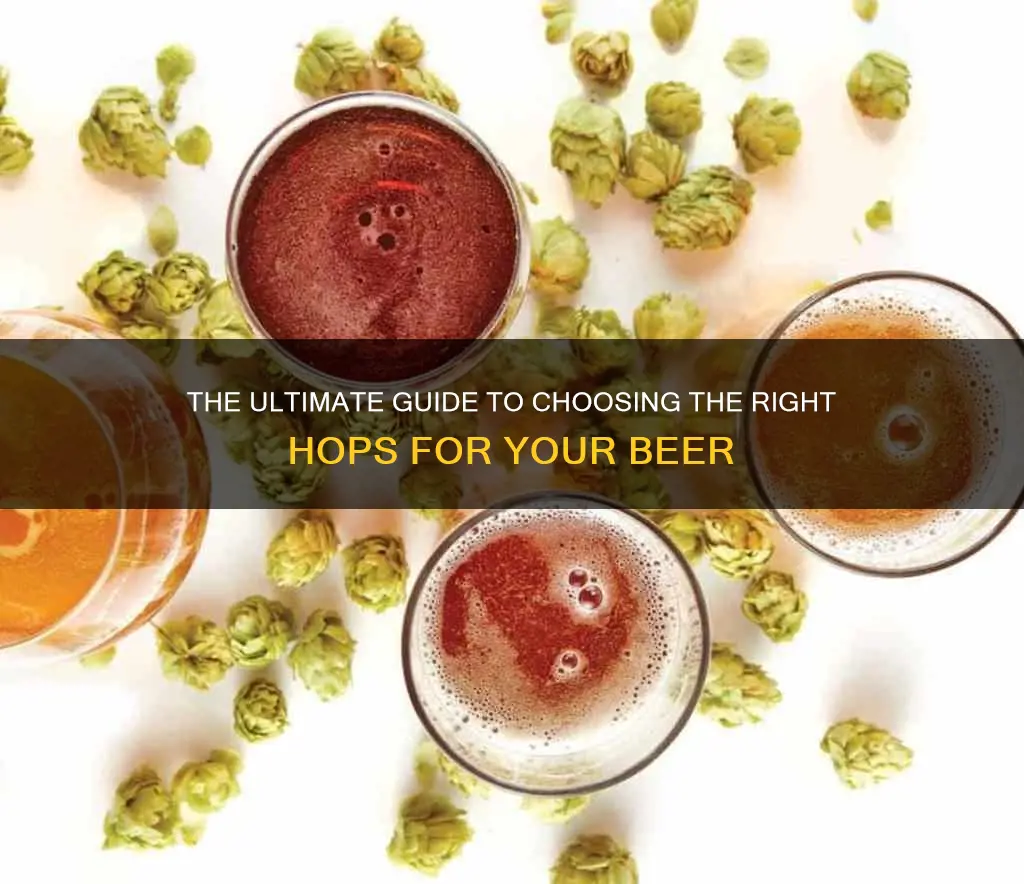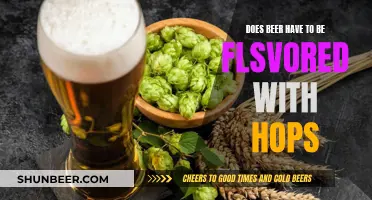
Hops are the flowers of the hop plant Humulus lupulus, a member of the Cannabaceae family. They are used to balance the sweetness of malt with bitterness and a variety of flavours and aromas. Hops are categorised as either bittering hops, which have higher concentrations of alpha acids, or aroma hops, which have more essential oils. The type of hop used depends on the style of beer being brewed. For example, American hops like Cascade and Centennial tend to be bold, bright, and highly aromatic, whereas English hops like Fuggle have more subtle, delicate, and mild notes.
| Characteristics | Values |
|---|---|
| Type | Bittering or Aroma |
| Alpha Acid Content | High or Low |
| Beta Acid Content | High or Low |
| Aromatic Properties | Aromatic or Not |
| Flavour | Citrus, Pine, Mango, Melon, Resin, Floral, Spicy, Tropical Fruits, Wood, Cedar, Earthy, Herbal, Mint, Pepper, Chocolate, Molasses, Tea, Grapefruit, Lemon, Lime, Orange, Coconut, Stone Fruits, Tropical Fruits, Black Pepper, Cinnamon, Black Tea, etc. |
What You'll Learn

Hops for bitterness
Hops are the flowers (also called seed cones or strobiles) of the hop plant Humulus lupulus. They are one of the four basic ingredients of beer and are primarily used as a bittering, flavouring, and stability agent. Hops balance the sweetness of the malt with bitterness, adding flavour and aroma to the beer.
The alpha acids in hops are the main source of bitterness in beer. The alpha acids are isomerized into iso-alpha acids during the wort boil, which is the main source of bitterness in the beer. The beta acids in hops are also important, as they oxidize and become more bitter as hops age, contributing to the overall bittering potential of the hops.
The degree of bitterness in beer depends on the type of hop, the amount used, and how it is used. Hops are generally divided into two categories: bittering hops and aroma hops. Bittering hops have higher concentrations of alpha acids and are responsible for most of the bitter flavour in beer. Aroma hops, on the other hand, have lower alpha acid concentrations and contribute more to the hop aroma and flavour.
When brewing beer, bittering hops are boiled for a longer period of time, typically 60-90 minutes, to extract their bittering qualities. Aroma hops are added later in the brewing process, during the final 30 minutes or less of the boil, to prevent the evaporation of essential oils and to impart "hop taste" and "hop aroma".
Different varieties of hops will produce different flavours and aromas in beer. Some common hops used for bitterness include Admiral, Bramling, Chinook, and Hallertauer Magnum. These hops can be used in a variety of beer styles, such as American India Pale Ale, Imperial India Pale Ale, and Extra Special Bitter.
In addition to hops, bitterness in beer can also come from other sources such as fruits, herbs, and vegetables added during the brewing process. For example, orange zest, spruce tips, and juniper can contribute to bitterness.
Grow Your Own Hops for Beer: A Step-by-Step Guide
You may want to see also

Hops for aroma
Hops are the flowers, or cones, of the plant Humulus lupulus and are one of the four main ingredients in beer. They are used to add aroma, flavour, and bitterness, as well as to act as a stabilising agent. Hops are divided into two general categories: bittering hops and aroma hops.
Aroma hops are specifically cultivated for their aromatic qualities in beer brewing. They are rich in essential oils and are added during the later stages of the brewing process, typically during the last 5 to 20 minutes of the boil, or during whirlpooling or dry hopping. This maximises their aroma contributions while minimising the extraction of bitter alpha acids. Aroma hops usually have a lower concentration of alpha acids (less than 10%) and a 1:1 ratio of alpha to beta acid content. This makes it difficult to add a significant amount of bitterness to a beer.
There are four main essential oils that contribute to the aroma of hops: myrcene, humulene, caryophyllene, and farnesene. Myrcene is the most prominent oil and adds resinous pine, citrus, and fruity flavours to beer. Humulene is the second most abundant oil and adds woody, hoppy, and spicy notes. Caryophyllene, typically 5-20% of all oils in a particular hop, adds black pepper, spicy, and herbal aromas. Farnesene is often found in only trace amounts and, when present, adds fresh, green, and woody aromas. In addition to these four, there are over 10 other possible oils within hops, though most are at undetectable levels or do not contribute significantly to the overall flavour.
Noble hops are a type of aroma hop with a long history. The term 'noble' has been used since the 1980s to refer to hops that have been used in brewing beer for centuries. There are four varieties of noble hops: Hallertau Mittelfrüh, Saaz, Spalt, and Tettnanger. They all have German names, but Saaz is grown in the Czech Republic. American substitutes for noble hops include US Fuggle, Liberty, Mt. Hood, Vanguard, and Willamette hops.
Aroma hops are vital in crafting a beer's sensory profile, particularly for styles that emphasise hop-forward flavours and aromas, such as IPAs, pale ales, and pilsners. By carefully selecting and combining different aroma hop varieties, brewers can create a unique, well-rounded, and complex beer character.
Hops Toxicity in Dogs: Beer Hops' Harmful Effects
You may want to see also

Noble hops
The four classic noble hops are:
- Hallertauer Mittelfrüh: Cultivated in specific regions of Germany for hundreds of years, Hallertauer Mittelfrüh is a classic German aroma hop with an intense, pleasantly harmonic bitterness. It is commonly used in German pilsners, traditional lagers, Belgian ales, and European ales.
- Tettnanger: Originating from the town of Tettnang in Germany, Tettnanger hops display fine, noble characteristics with a slight spiciness. They are ideal for dry hopping and can be found in beers such as bitter, California blonde ale, red ale, pilsner, and lager.
- Spalt: Also known as Spalter, this variety originates from the Spalt region in southern Germany. It is an aroma hop with characteristics similar to German Tettnang. Spalt is commonly used in German ales, lagers, pilsners, and bocks.
- Saaz: A Czech Republic landrace variety, Saaz is the most classic "noble" aroma hop, defining Czech-style pilsners. It is known for its earthy, herbal, grassy, floral, and spicy notes. Saaz hops are commonly used in Bohemian-style beers, continental lagers, wheat beers, and pilsners.
It is important to note that the term "noble hops" is not scientifically defined but is rather a marketing term used by brokers and brewers. Nevertheless, noble hops are highly regarded in the beer world for their quality, consistency, and unique characteristics imparted to beer.
Dry Hopping Beer: Pellet Power for Aromatic Brews
You may want to see also

American hops
Some of the most popular American hops include:
- Citra: A high alpha acid hop with a strong, yet smooth floral and citrus aroma and flavor. Citra hops have specific aroma descriptors that include grapefruit, citrus, peach, melon, lime, gooseberry, passion fruit, and lychee.
- Cascade: The most popular variety in craft brewing, known for its unique floral, spicy, and citrus character with balanced bittering potential.
- Mosaic: Contains high alpha content and features a unique and complex aroma profile that translates favorably into a variety of beer styles.
- Simcoe: Simcoe hops are known for their brewing versatility and unique aroma characteristics. They contain high alpha and continue to rise in popularity, becoming one of the top ten varieties in craft and home brewing industries.
- Amarillo: A dual-purpose hop that is good for bittering and has amazing aromatics, making it a versatile, dual-purpose brewing ingredient.
Dry Hopping Tea in Beer: Enhancing Aromatics
You may want to see also

English hops
The flavours of English hops tend to be more complex and less clean than Continental or American hops. They can vary from fruity to earthy, woody, and grassy. English hops are also known for their delicate, complex aromas, with some varieties having significant intensity. The complexity and earthy/woody notes are at the heart of many English and British beer styles.
Malt, Hops, and Cider: What's in Your Beer?
You may want to see also
Frequently asked questions
Hops are the flowers of the hop plant, Humulus lupulus. They are used to add bitterness, flavour and stability to beer.
Hops are generally divided into two types: bittering hops and aroma hops. Bittering hops have higher concentrations of alpha acids, while aroma hops tend to have more essential oils.
Some examples of bittering hops include Admiral, Bravo, Bullion, Cluster, and Northern Brewer.
Some examples of aroma hops include Amarillo, Cascade, Centennial, Citra, and Mosaic.







